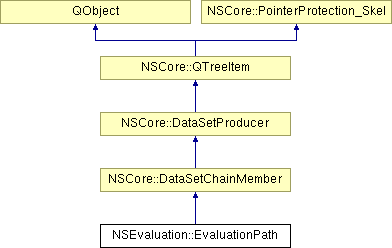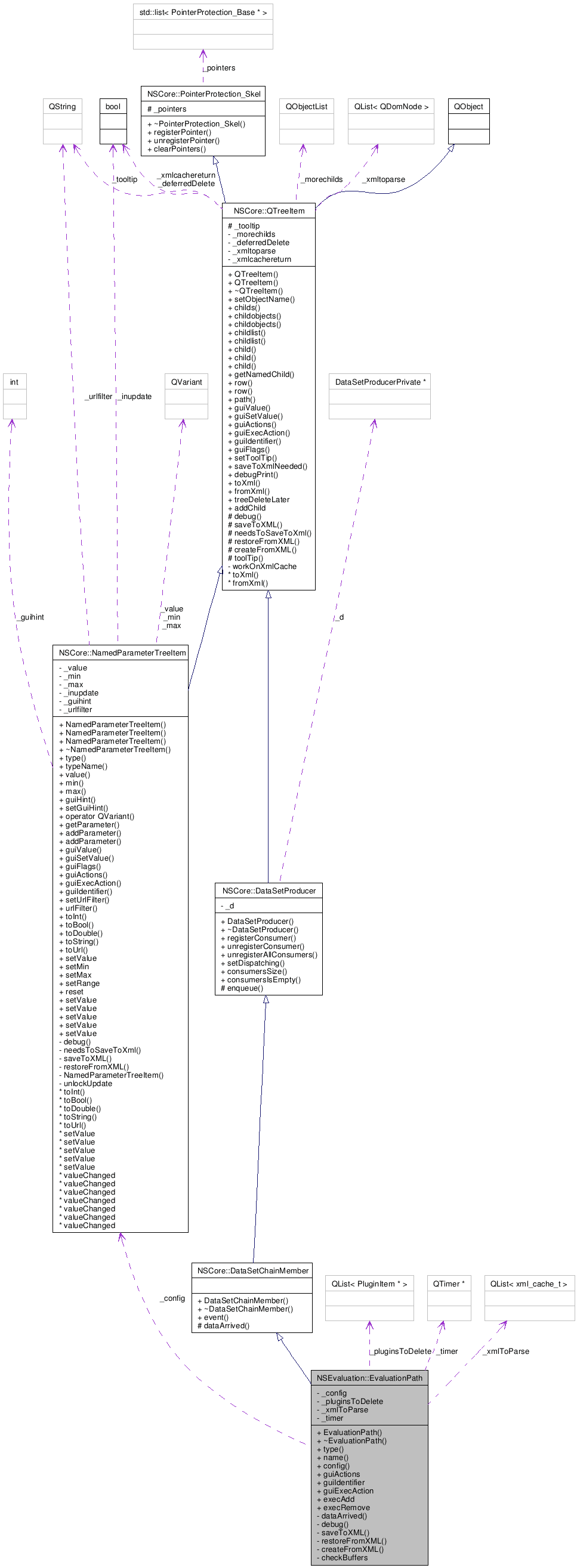NSEvaluation::EvaluationPath Class Reference
The path of evaluation. More...
#include <evaluationpath.h>


Public Slots | |
| QStringList | guiActions () const |
| GUI: return the supported actions. | |
| QVariant | guiIdentifier (int) const |
| GUI: return different types of data used to identify the treeitem. | |
| void | guiExecAction (QString action, NSCore::GuiServer_Interface *gui) |
| GUI: execute the named action. | |
| void | execAdd (NSCore::QTreeItem *, NSCore::GuiServer_Interface *) |
| void | execRemove (NSCore::QTreeItem *, NSCore::GuiServer_Interface *) |
Signals | |
| void | pluginsChanged () |
| some plugins have changed. | |
| void | newPlugin (NSEvaluation::PluginItem *plugin, NSCore::QTreeItem *parent) |
| inform the gui ( or a frontend ) of a new plugin | |
Public Member Functions | |
| EvaluationPath (QObject *=0, NSCore::QTreeItem *=0) | |
| constructor | |
| ~EvaluationPath () | |
| destructor | |
| QString | type () const |
| QString | name () const |
| NSCore::NamedParameterTreeItemPointer | config () |
| Access the configuration. | |
Private Slots | |
| void | checkBuffers () |
Private Member Functions | |
| bool | dataArrived (NSCore::AcqisitionDataSet &) |
| Data arrived! | |
| QString | debug () const |
| Custom debug text. | |
| QDomNode | saveToXML (QDomDocument doc) |
| Store the information of this element into a new QDomElement. | |
| bool | restoreFromXML (QDomNode node) |
| Restore the state of this element from the given QDomNode. | |
| bool | createFromXML (QDomNode) |
| Create childs from XML. | |
Private Attributes | |
| NSCore::NamedParameterTreeItem * | _config |
| QList< PluginItem * > | _pluginsToDelete |
| QList< xml_cache_t > | _xmlToParse |
| QTimer * | _timer |
Classes | |
| struct | xml_cache_t |
Detailed Description
The path of evaluation.While this has to be connected to an AcqisitionDataSetBuffer to get its input-data, it is an AcqisitionDataSetBuffer itself which sends out the evaluated data.
To have an own thread for the evaluationpath use NSCore::Thread_Template
Constructor & Destructor Documentation
| NSEvaluation::EvaluationPath::EvaluationPath | ( | QObject * | = 0, |
|
| NSCore::QTreeItem * | = 0 | |||
| ) |
constructor
| NSEvaluation::EvaluationPath::~EvaluationPath | ( | ) |
destructor
Member Function Documentation
| QString NSEvaluation::EvaluationPath::type | ( | ) | const [inline] |
| QString NSEvaluation::EvaluationPath::name | ( | ) | const [inline] |
| NSCore::NamedParameterTreeItemPointer NSEvaluation::EvaluationPath::config | ( | ) | [inline] |
| QStringList NSEvaluation::EvaluationPath::guiActions | ( | ) | const [inline, virtual, slot] |
GUI: return the supported actions.
These actions will get symbols/buttons to get executed.
If you implement this, remember to call the parent guiActions() too:
SomeTreeItem::guiActions() const { return QStringList() << <your actions> << BaseClass::guiActions(); }
Reimplemented from NSCore::QTreeItem.
| QVariant NSEvaluation::EvaluationPath::guiIdentifier | ( | int | role | ) | const [virtual, slot] |
GUI: return different types of data used to identify the treeitem.
Things like the name, icon, statustip, tooltip and so on will be accessed by this.
- Parameters:
-
role is actually a combination of Qt::ItemDataRole
Reimplemented from NSCore::QTreeItem.
| void NSEvaluation::EvaluationPath::guiExecAction | ( | QString | n, | |
| NSCore::GuiServer_Interface * | gui | |||
| ) | [virtual, slot] |
GUI: execute the named action.
If you implemented guiActions() you will also want to implement this. If you can't handle the named action yourself, call guiExecAction() of the parent class.
Of course this can also be used as a filter if you want to restrict access to actions of the parent class.
The second parameter lets you interact with the user by some basic means.
- Parameters:
-
n The action to execute gui The gui to use for interactions
Reimplemented from NSCore::QTreeItem.
| void NSEvaluation::EvaluationPath::execAdd | ( | NSCore::QTreeItem * | , | |
| NSCore::GuiServer_Interface * | ||||
| ) | [slot] |
| void NSEvaluation::EvaluationPath::execRemove | ( | NSCore::QTreeItem * | , | |
| NSCore::GuiServer_Interface * | ||||
| ) | [slot] |
| void NSEvaluation::EvaluationPath::pluginsChanged | ( | ) | [signal] |
some plugins have changed.
This signal is emitted when the plugins have change. It is used for the gui to update the representation of the plugin-tree.
| void NSEvaluation::EvaluationPath::newPlugin | ( | NSEvaluation::PluginItem * | plugin, | |
| NSCore::QTreeItem * | parent | |||
| ) | [signal] |
inform the gui ( or a frontend ) of a new plugin
| void NSEvaluation::EvaluationPath::checkBuffers | ( | ) | [private, slot] |
| bool NSEvaluation::EvaluationPath::dataArrived | ( | NSCore::AcqisitionDataSet & | ) | [private, virtual] |
Data arrived!
Subclass this function to handle the data. Return true when the data should be sent to the next in the chain. Otherwise it gets deleted.
Implements NSCore::DataSetChainMember.
| QString NSEvaluation::EvaluationPath::debug | ( | ) | const [inline, private, virtual] |
Custom debug text.
This function has to be implemented and has to return the internal debug-data that is to be printed...
Implements NSCore::QTreeItem.
| QDomNode NSEvaluation::EvaluationPath::saveToXML | ( | QDomDocument | doc | ) | [inline, private, virtual] |
Store the information of this element into a new QDomElement.
This function is only to save the state of this element, all the recursive stuff will be done by toXml().
- Parameters:
-
doc The QDomDocument to use for creation of the element
Implements NSCore::QTreeItem.
| bool NSEvaluation::EvaluationPath::restoreFromXML | ( | QDomNode | node | ) | [inline, private, virtual] |
Restore the state of this element from the given QDomNode.
You don't have to do the recursive stuff here, that is handled in fromXml() for you. Only the things done in saveToXML need/can be restored here.
If you succeeded and want the childs to be restored too, return true.
- Parameters:
-
node The QDomNode to restore from
Implements NSCore::QTreeItem.
| bool NSEvaluation::EvaluationPath::createFromXML | ( | QDomNode | node | ) | [private, virtual] |
Create childs from XML.
On fromXml() this gets called after successfull return from restoreFromXML(). If you want to create childs of this item from the childs of the QDomNode given, you can do so.
The return value defines whether fromXml will be called on the childs for the child-xml-items.
The default implementation returns true, so the child items get a chance to restore their state too.
- Parameters:
-
node The QDomNode to restore from
Reimplemented from NSCore::QTreeItem.
Member Data Documentation
Referenced by config().
QList<PluginItem*> NSEvaluation::EvaluationPath::_pluginsToDelete [private] |
QList<xml_cache_t> NSEvaluation::EvaluationPath::_xmlToParse [private] |
QTimer* NSEvaluation::EvaluationPath::_timer [private] |
The documentation for this class was generated from the following file:
 1.5.5
1.5.5